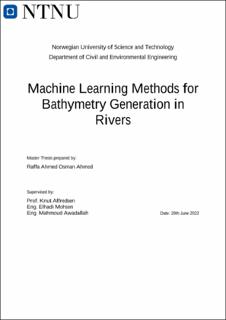| dc.description.abstract | Natural flood hazards resulted in more than 500,000 reported deaths during the last 20 years. This number is expected to increase in the future due to population growth, rapid urbanization and increased rainfall intensities induced by climate change. Hydrodynamic models are essential tools for simulating flooding events for proper risk management. Topographical and bathymetrical data are essential inputs for hydrodynamic models. One of the promising technology for Topographical and bathymetrical data collection is the LiDAR (Light Detection And Ranging) which has emerged in the last years. Two LiDAR technologies exist; Red LiDAR and Green LiDAR. The former cannot penetrate water surfaces while the latter can. In Norway, Green LiDAR data are collected for only few rivers while Red LiDAR data are available for most of the rivers. This study sough to investigate the suitability of two Machine learning (ML) methods, Artificial neural network (ANN) and Convolutional neural network (CNN), for extracting river bathymetry for Red Lidar data. ML models were trained in Gaula river in Norway with Green LiDAR data. Four different model training scenarios and two activation functions of ANN were tested. The accuracy of the trained ML models was tested at different reaches of Gaula from the ones used for model training and at two other rivers in Norway, Driva and Surna. Moreover, the study investigated the accuracy of the hydraulic simulations by using bathymetrical data generated by the trained ML models. The preliminarily results of the CNN were promising. However, the method was found to be computationally costly and time consuming. For ANN, the selection of input data and the choice of activation functions were found to influence the accuracy of the results. Trained ANN models were able to predict bathymetrical data with reasonable accuracy in most of the cross-sections of Gaula river. Trained ANN could also yield accurate estimation of bathymetrical data when evaluated at Driva and Surna rivers. Prediction accuracy was generally low for cross-sections that vary significantly from the ones used for model training and for cross-sections that contain islands. Regarding hydraulic simulations, terrains estimated by ANN decreased the inundation area error significantly when compared with Red LiDAR simulations. Therefore, well-trained ANN can be used to predict bathymetrical for Red LiDAR in order to improve the accuracy of hydraulic simulations. | |
